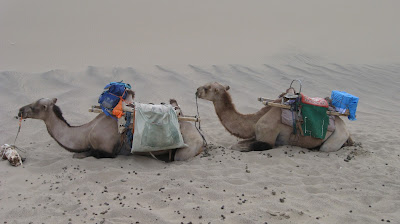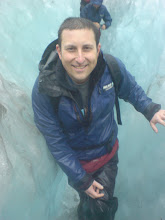Leaving Mr. Li's House:

The Cemetery:


The wind makes interesting shapes in the dunes, and there was lots to see as we headed towards that night's camp site.



Desert Hare:

Intrepid Explorers:

After a few hours, we arrived and helped Mr. Li set up camp, after which Abe and I walked up one of the dunes to see the view, while Mr. Li made a fire and sorted out dinner: instant noodles, and the most amazing bread stuck on sticks and warmed by the fire. A few beers later, and we were ready to call it a night.
Climbing the dunes:

Our first camp site:




The next day we headed off on the camels again through the most amazing desert scenery. One thing I've learned about camels is that they are amazingly greedy and will try and eat at any point they can. The other thing is – they can be unbelievably stubborn.
As we were heading up one of the dunes, my camel refused to go any further, and after some scary moments on the top of the steep dune, the wooden bit that controlled my camel came free. As Mr. Li and Abe headed down the other side of the steep dune, my camel looked like it was going to make a run for it.
Mr. Li had to put the wooden bit through my camel's nose and there was all sorts of fun and games as the camel protested – even spitting on Mr. Li at one point.
And then we headed back on through the desert to the entrance to the Mogao caves.


The Mogao caves are an amazing collection of small grottoes developed over a one thousand year period between the 4th and 14th century. What makes them remarkable is the art work inside is representative of all of the periods over which the caves were constructed.
At some point, and for an unknown reason the caves were abandoned, and an earthquake resulted in the caves being entirely covered in sand.
Following discovery at the turn of the 20th Century, archeologists from Europe removed some of the statues and a significant majority of the manuscripts found in a hidden “library” cave, and in some cases actually cut out part of the paintings from the walls for display in European and American museums.
Thankfully not too much damage was done.
The caves inaccessibility and distance from Beijing meant that during the Cultural Revolution – when a significant majority of China's religious past was destroyed by the government – the caves were spared.
Amazingly – one of the governments own ministers had the foresight to protect the caves in the early 70's, giving a significant sum of money from his own pocket to construct a concrete reconstruction of the original wood buildings to preserve the caves. And while some of the exterior looks like a 70's pebble dashed house, it's protected the paintings from further damage.
The dry climate here means that the caves and the paintings within have retained much of their original colour – although further work is on going to protect the paintings. Of the more than 400 caves only a few are opened each day to tourists and these are always rotated. Absolutely no photography is allowed inside - they even make you leave your camera at a locker room before being allowed to enter, and you have to be escorted by a guide.
The Mogao Caves - the wooden structure is how it would have all looked years ago:

Temple built in the 1920's to replace an earlier structure. Inside - the world's third largest Buddha:

The 70's façade:

Mogao's famous ancient street art dating back to the early 21st century:

"Interesting" English presentation in the exhibition centre:

Ariel view taken from our hot air balloon :-)

The caves where people lived while the temples were active:

While we were looking around the caves a sandstorm had started, and it was getting increasingly windy as we walked back to meet Mr. Li. There was a lot of sand in the air, and visibility was starting to reduce. And as we set off back into the desert, the weather began to deteriorate...

No comments:
Post a Comment